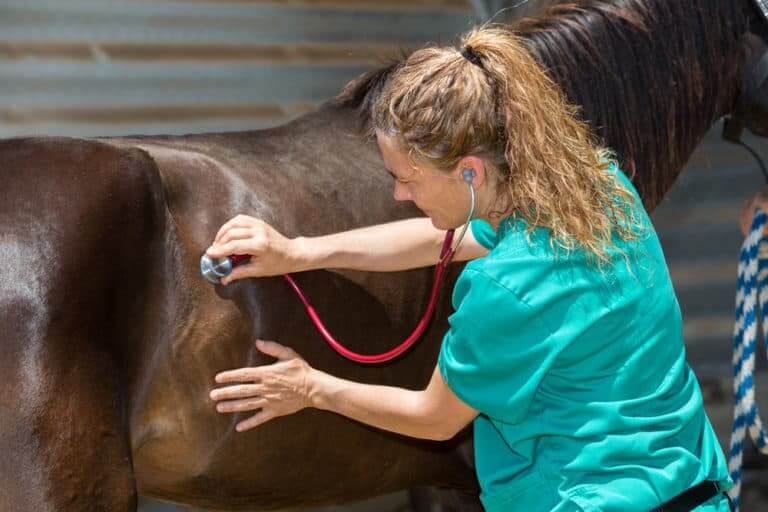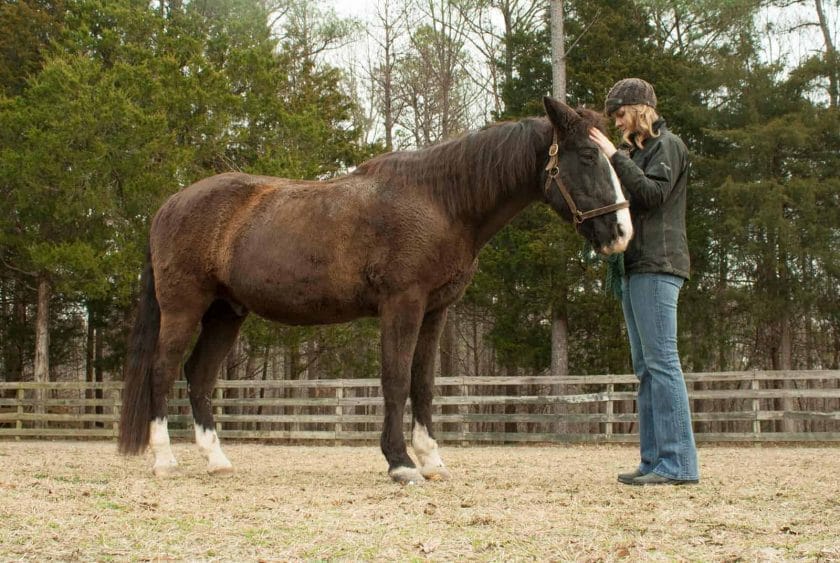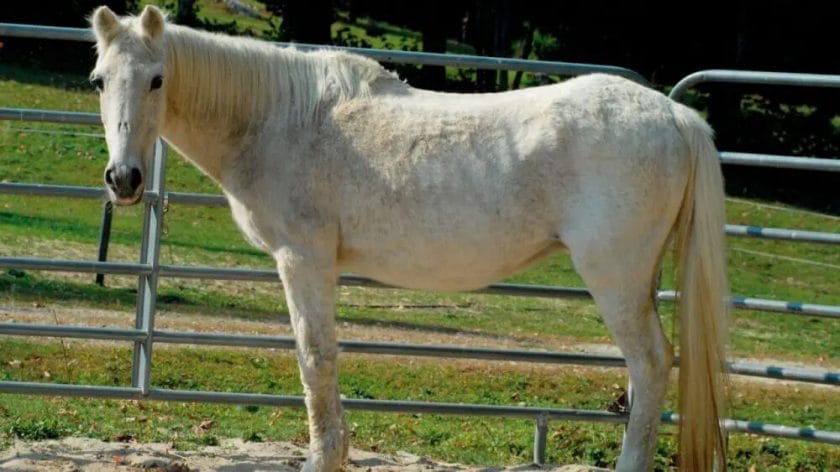Yes, you can ride a horse with Cushing’s disease, but it requires careful management and consideration of the horse’s health. Cushing’s disease, also known as pituitary pars intermedia dysfunction (PPID), is a hormonal disorder commonly found in older horses. It can affect their overall well-being and performance. However, with proper veterinary care, medication, and appropriate exercise regimens, many horses with Cushing’s disease can continue to be ridden and enjoy a good quality of life.

Managing Cushing’s Disease in Horses: Treatment Options and Dietary Considerations
Cushing’s Disease, also known as Pituitary Pars Intermedia Dysfunction (PPID), is a common endocrine disorder in horses, particularly in older equines. This chronic condition affects the pituitary gland, leading to excessive production of a hormone called adrenocorticotrophic hormone (ACTH).
Symptoms and Diagnosis
The symptoms of Cushing’s Disease in horses can vary but commonly include weight loss, excessive hair growth, muscle wasting, increased urination and drinking, lethargy, laminitis, and a compromised immune system. If you suspect your horse may have Cushing’s Disease, it is crucial to consult with a veterinarian for a proper diagnosis.
Treatment Options
1. Medications: The primary treatment for Cushing’s Disease in horses involves the administration of medications such as pergolide or cyproheptadine. These drugs work by reducing the production of excessive hormones in the pituitary gland, managing the symptoms and slowing the progression of the disease.
2. Dietary Changes: In addition to medication, making dietary changes can help support horses with Cushing’s Disease. Providing a low-sugar and low-starch diet is essential to maintaining their overall health. Feeding high-quality forage, such as grass hay, can help control blood sugar levels and prevent weight gain.
Dietary Considerations
1. Limit Sugar and Starch Intake: Horses with Cushing’s Disease are prone to insulin resistance, so it is crucial to restrict their intake of sugar and starch. Avoid feeding grains, sweet feeds, and sugary treats. Instead, opt for feeds designed specifically for horses with metabolic disorders that contain low levels of non-structural carbohydrates.
2. Provide Adequate Fiber: Good quality forage is a key component of a Cushing’s horse’s diet. Feeding grass hay or haylage can help provide the necessary fiber and aid in controlling blood sugar levels. Avoid feeding legume hay, as it tends to be higher in sugar content.
3. Supplementation: Certain supplements can support the overall health of horses with Cushing’s Disease. Antioxidants, such as vitamin E and selenium, can help boost the immune system. Omega-3 fatty acids, found in flaxseed or fish oil, have anti-inflammatory properties that may benefit these horses.
4. Regular Exercise: Exercise plays a vital role in managing Cushing’s Disease in horses. Regular exercise helps maintain a healthy weight, improve muscle tone, and support overall fitness. However, it is important to tailor the exercise routine to the individual horse’s physical capabilities.
5. Monitoring: Regular monitoring of the horse’s condition, including bloodwork and hormone level testing, is crucial for managing Cushing’s Disease effectively. This allows for adjustments in medication dosages and dietary plans as needed.
In Summary
Managing Cushing’s Disease in horses requires a multi-faceted approach. Along with medication, dietary considerations play a significant role in supporting the horse’s overall health. Providing a low-sugar, low-starch diet, ensuring adequate fiber intake, and incorporating appropriate supplements can help manage the symptoms and improve the quality of life for horses with this condition. Regular veterinary monitoring and tailored exercise routines are also essential components of successful management. By implementing these strategies, horse owners can help their equine companions live comfortably with Cushing’s Disease.

Tips for Riding a Horse with Cushing’s Disease: Exercise and Training Techniques
Riding a horse can be a rewarding and enjoyable experience, but when your equine partner has Cushing’s disease, there are some additional considerations to keep in mind. Cushing’s disease, also known as pituitary pars intermedia dysfunction (PPID), is a common condition in older horses that affects their hormone levels and can lead to a range of health issues. However, with the right exercise and training techniques, you can help your horse maintain their health and continue to enjoy riding together. In this section, we will explore some valuable tips for riding a horse with Cushing’s disease.
1. Consult with Your Veterinarian
Before implementing any exercise or training program, it is crucial to consult with your veterinarian. They will be able to assess your horse’s condition and recommend appropriate exercise levels based on their individual needs. Your vet may also suggest specific exercises or modifications to accommodate any joint or muscle issues that may be associated with Cushing’s disease.
2. Gradual Intensity Increase
When working with a horse with Cushing’s disease, it is important to gradually increase the intensity of exercise. This allows your horse’s body to adjust and reduces the risk of injury or exacerbating any existing health conditions. Start with shorter, low-intensity rides and gradually increase the duration and difficulty as your horse becomes more comfortable.
3. Frequent Walk Breaks
During your rides, be sure to incorporate frequent walk breaks. Walking is a low-impact exercise that can help improve circulation and joint mobility while providing a break from more strenuous activities. These breaks also give your horse a chance to catch their breath and relax, which can be beneficial for managing stress levels associated with Cushing’s disease.
4. Focus on Flexibility and Suppleness
Cushing’s disease can sometimes lead to stiffness in horses, so incorporating exercises that focus on flexibility and suppleness can be beneficial. This can include lateral movements, bending exercises, and stretching exercises to encourage your horse to use their entire body and maintain range of motion in their joints.
5. Mindful Warm-Up and Cool-Down
Prior to each ride, take the time to warm up your horse properly. This can include walking in hand, gentle stretches, and lunging to loosen up their muscles. After the ride, allow for a proper cool-down period to help your horse gradually settle their heart rate and body temperature. Cooling down can be done through walking and light stretching exercises.
6. Regular Turnout
Providing regular turnout for your horse is essential for their overall well-being. Turnout allows horses to move freely, stretch their legs, and socialize with other equine companions. It can also help manage weight and reduce the risk of complications associated with Cushing’s disease. Be sure to provide a safe and suitable turnout environment tailored to your horse’s specific needs.
7. Monitor Your Horse’s Condition
Regularly monitor your horse’s condition and keep a close eye on any changes in behavior or physical appearance. This can include checking for weight loss or gain, changes in coat quality, and any signs of discomfort or lameness. By staying vigilant, you can address any potential issues promptly and adjust your exercise and training program as needed.
8. Consider Alternative Training Methods
If your horse’s health condition limits their ability to engage in traditional riding exercises, consider alternative training methods. Groundwork exercises, such as lunging, long-lining, or liberty work, can provide mental and physical stimulation while reducing the strain on your horse’s body. These exercises can also be used alongside ridden work to create a well-rounded training program.
By following these tips and working closely with your veterinarian, you can create a tailored exercise and training program that suits your horse’s needs and supports their overall health and well-being, even with Cushing’s disease. Remember to always prioritize your horse’s comfort and monitor their condition closely to ensure a safe and enjoyable riding experience.

Equestrian Gear for Horses with Cushing’s Disease: Saddle Fitting and Comfort
Horses with Cushing’s disease require special care and attention, especially when it comes to their equestrian gear. Saddle fitting and comfort are two crucial factors that need to be considered to ensure the well-being and performance of these horses. In this section, we will explore the importance of proper saddle fitting and discuss the various equestrian gear options available for horses with Cushing’s disease.
The Importance of Proper Saddle Fitting
Proper saddle fitting is essential for all horses, but it becomes even more critical for horses with Cushing’s disease. This condition can cause changes in the shape and musculature of the horse, making it challenging to find a saddle that fits correctly. An ill-fitting saddle can lead to discomfort, soreness, and even injury for the horse. Therefore, it is crucial to work closely with a professional saddle fitter who has experience with horses with Cushing’s disease.
A professional saddle fitter will take precise measurements of the horse’s back and consider any changes in muscle tone caused by Cushing’s disease. They will also assess the horse’s movement and behavior under the saddle to ensure a proper fit. The saddle should distribute the rider’s weight evenly across the horse’s back and provide sufficient clearance for the withers and spine.
Equestrian Gear Options
When it comes to equestrian gear for horses with Cushing’s disease, certain options can enhance comfort and alleviate any potential issues. Let’s explore some of these options:
1. Cushioned Saddle Pads
Cushioned saddle pads can be beneficial for horses with Cushing’s disease. These pads provide extra cushioning and support, reducing pressure points and minimizing discomfort. Look for saddle pads that are specifically designed for horses with back issues or sensitive skin.
2. Contoured Girths
A contoured girth can help distribute pressure evenly and prevent the saddle from slipping. It is essential to choose a girth that is well-padded and made from a soft material to avoid chafing or rubbing. Some contoured girths are designed with elastic inserts or adjustable buckles, allowing for a customized fit.
3. Flexible Tree Saddles
Flexible tree saddles are designed to accommodate the changing shape and musculature of the horse’s back. These saddles have a tree that can flex and adjust to the horse’s movement, providing a more comfortable fit. They are particularly suitable for horses with Cushing’s disease, as their back shape may fluctuate due to the condition.
4. Pressure-Distributing Pads
Pressure-distributing pads are another excellent option for horses with Cushing’s disease. These pads are strategically designed to redistribute weight and pressure away from sensitive areas, such as the withers and spine. They can help alleviate discomfort and prevent the development of pressure sores.
5. Custom-Made Saddles
For horses with extreme back changes caused by Cushing’s disease, a custom-made saddle may be the best option. A saddle crafted specifically for the horse’s unique shape and needs will ensure the highest level of comfort and support. Working with a skilled saddle maker or fitter who understands the challenges of Cushing’s disease is crucial in this case.
Summary
Proper saddle fitting and comfort are paramount for horses with Cushing’s disease. Working with a professional saddle fitter and considering specialized equestrian gear options can significantly enhance the well-being and performance of these horses. Cushioned saddle pads, contoured girths, flexible tree saddles, pressure-distributing pads, and custom-made saddles are all viable options to ensure the utmost comfort and support for horses with Cushing’s disease.
Monitoring and Preventing Complications in Horses with Cushing’s Disease
Horses with Cushing’s disease, also known as Pituitary Pars Intermedia Dysfunction (PPID), require ongoing monitoring and preventive care to manage the condition effectively and minimize the risk of complications. Cushing’s disease is a common endocrine disorder in older horses, characterized by the overproduction of cortisol. This hormonal imbalance can lead to various health issues and the development of secondary conditions. In this section, we will discuss the importance of monitoring and outline preventive measures for horses with Cushing’s disease.
1. Regular Veterinary Check-ups
Regular veterinary check-ups are essential for horses with Cushing’s disease to monitor their overall health and detect any changes or complications early on. During these check-ups, veterinarians will perform physical examinations, blood tests, and other diagnostic procedures to assess the horse’s condition. It is recommended to schedule check-ups at least twice a year, but the frequency may vary depending on the severity of the disease and the horse’s individual needs.
2. Hormone Level Monitoring
Monitoring hormone levels, particularly cortisol and ACTH (adrenocorticotropic hormone), is crucial in managing Cushing’s disease. High levels of cortisol and ACTH are indicative of uncontrolled disease progression. Regular blood tests can help determine the effectiveness of the treatment and adjust medication dosages if necessary. Hormone level monitoring should be done in collaboration with a veterinarian experienced in managing Cushing’s disease.
3. Dentistry and Dental Care
Horses with Cushing’s disease are prone to dental problems such as periodontal disease and tooth decay. Regular dental examinations and proper dental care, including routine teeth floating, are essential to maintain oral health. Dental issues can impact a horse’s ability to eat and lead to weight loss or malnutrition. Addressing dental problems promptly can help prevent complications and ensure the horse’s overall well-being.
4. Weight Management and Exercise
Weight management is crucial for horses with Cushing’s disease, as obesity can exacerbate the condition and increase the risk of laminitis and other complications. A balanced diet tailored for horses with Cushing’s should be provided, with controlled intake of sugars and starches. Regular exercise, such as daily turnout or light exercise, can also aid in weight management and promote overall health. However, exercise should be moderate and suitable for the horse’s condition, as strenuous activity can be detrimental.
5. Preventing Laminitis
Laminitis, a painful and potentially debilitating hoof condition, is a common complication in horses with Cushing’s disease. Preventive measures should be taken to reduce the risk of laminitis development. This includes regular hoof care, proper trimming, and maintaining appropriate hoof angles. Limiting access to lush pasture and providing a well-balanced diet with low sugar and starch content can also help prevent laminitis episodes.
6. Medication Management
Horses with Cushing’s disease often require medication to manage their condition effectively. It is essential to follow the veterinarian’s prescribed treatment plan and medication schedule diligently. Any changes in medication should be communicated to the veterinarian, who can monitor the horse’s response and adjust the treatment as needed. Regular check-ups and communication with the veterinarian are crucial in ensuring optimal medication management.
7. Environmental Management
Environmental factors can impact horses with Cushing’s disease, so it is important to manage their living conditions appropriately. Providing a clean and dry environment, free from mold and dust, helps prevent respiratory issues that can worsen the horse’s overall health. Protection from extreme weather conditions, particularly heat stress and prolonged exposure to direct sunlight, is also important. Regular turnout and social interaction with other horses can promote mental and physical well-being.
Summary
Monitoring and preventing complications in horses with Cushing’s disease play a vital role in maintaining their overall health and well-being. Regular veterinary check-ups, hormone level monitoring, dental care, weight management, and exercise are key aspects of preventive care. Additionally, preventing laminitis, proper medication management, and creating a suitable living environment are essential. By implementing these measures, horse owners can provide the best possible care for their equine companions with Cushing’s disease.
FAQs
Can you ride a horse with Cushing’s?
It depends on the severity of the condition and the recommendation of your veterinarian. Some horses with controlled Cushing’s disease can continue to be ridden, while others may need to be retired from riding due to the potential risk of lameness or other complications.
Conclusion
In conclusion, while individuals with Cushing’s disease may face certain challenges, riding a horse can still be possible with proper precautions and management. By working closely with medical professionals and experienced equestrian instructors, riders with Cushing’s can ensure their safety and enjoyment in the saddle. It is important to monitor symptoms, establish realistic goals, and make necessary adjustments to riding routines. With the right support and a focus on overall well-being, individuals with Cushing’s can continue to pursue their passion for horseback riding and maintain an active lifestyle.
In summary, Cushing’s disease should not be seen as a barrier to horse riding, but rather as a condition that requires careful management and adaptation. By being mindful of one’s health, seeking expert advice, and taking appropriate safety measures, individuals with Cushing’s can still experience the joy and thrill of horseback riding. Remember to prioritize your health and listen to your body, making informed decisions that align with your personal capabilities and overall well-being. So, saddle up, stay safe, and enjoy the ride!
